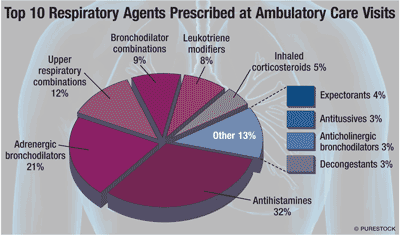US Pharm. 2011;36(7):8.
According to 2008 Statistical Abstract data, 1.2 billion Americans suffer from one or more forms of respiratory disease. Women aged 18 years and over have a greater prevalence of chronic bronchitis (68%), sinusitis (67%), asthma (59%), hay fever (58%), and emphysema (53%) than men; among patients aged younger than 18 years, however, boys outnumber girls. While asthma (53%) and sinusitis (42%) are most prevalent among patients aged 18 to 44 years, hay fever (44%), chronic bronchitis (43%), and emphysema (41%) are most prevalent among those aged 45 to 64 years.

Ambulatory Care: Upper respiratory tract infection is the most common reason for ambulatory care visits. Two-thirds of the total cost of treatment for respiratory diseases is spent in ambulatory care settings. Americans spend more than $1 billion each year on OTC medications for treating symptoms of upper respiratory tract infections that are mild, self-diagnosable, and self-treatable. Non–self-treatable upper and lower respiratory tract infections have been estimated by National Center for Health Statistics to cost $15 billion in direct treatment costs; physician charges account for 50% of these costs, hospital care accounts for 25%, and indirect costs are in excess of $9 billion. Sixty million patients with allergic rhinitis generate more than 15 million ambulatory visits and are predominantly prescribed oral or nasal second-generation antihistamines, decongestants, oral leukotriene modifiers, and nasal corticosteroids. Nosocomial respiratory infections affect 300,000 patients, and the cost of treatment is $470 million.
The graph shows the frequency of use of different categories of drugs for the treatment of respiratory diseases. The two drug categories most frequently used for the treatment of respiratory disease in ambulatory settings are bronchodilators and second-generation antihistamines.
Asthma: The 2008 Statistical Abstract data reveal that women have a higher prevalence of asthma (12.9 million; 84.6 per 1,000 population) than men (10.4 million; 71.1 per 1,000 population). The same trend is evidenced in incidence of asthma attack (7.3 million women vs. 5.4 million men). The death rate for asthma in the African American population (2.8 per 100,000) is three times higher than that in the white population (0.9 per 100,000). At $5.6 billion, prescription drugs for asthma treatment represent the largest single direct medical expenditure.
Drugs in Development: According to the American Pharmaceutical Manufacturers Association, 15 new drugs are in development for respiratory disorders. A recombinant humanized monoclonal antibody is being developed for the treatment of asthma. A Tufts report indicates that personalized medicine research is expanding into metabolic and respiratory therapies, as well as virology.
To comment on this article, contact rdavidson@uspharmacist.com.






